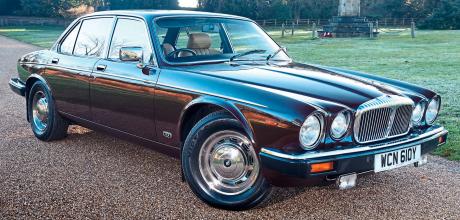1983 Daimler Sovereign Series 3 4.2 Manual
Any manual Jaguar XJ is a special occasion. But when it’s done just 29,000 miles, it becomes even more special. And when the manual XJ is in fact a Daimler Sovereign, the experience is almost unbeatable. Words Sam Skelton. Photography Paul Walton.
Shifting expectations Daimler Sovereign 4.2 manual
Any Series 3 with a manual gearbox is unusual, but more so when it’s a luxurious Daimler Sovereign. We track down a rare example and explain its significance
Since 1930, Daimler had been doing its level best to rid the driver of the necessity of changing their own gears. Indeed, from 1930 to the mid-Fifties it had sought to do away with the tiresome job of swapping cogs with the use of the Wilson pre-selector gearbox and a fluid flywheel.
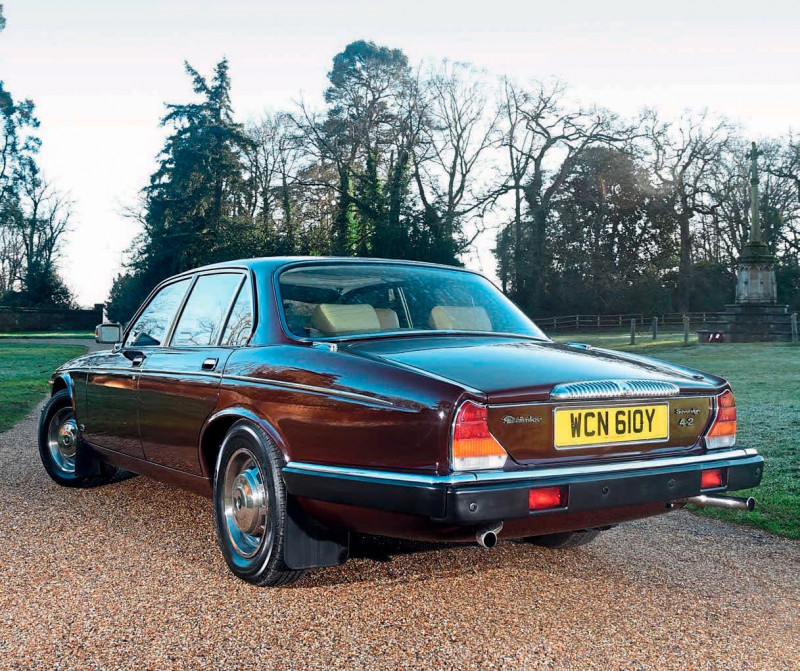
You would select your gear from a dash quadrant, rapidly depress and re-engage a pedal in place of a clutch, and the fluid flywheel would transmit drive in much the same manner as it does with today’s autos. No clutch, no lurching, it did almost everything for you in a far smoother manner than a conventional manual. No double declutching was needed, no perfect timing, no rev matching – even when the synchromesh made manuals easier to live with, the Wilson gearbox made life easier still. Daimler, in fact, inspired the world’s first fully automatic gearbox. So impressed was General Motors with the pre-selector concept that it bought a 1930 Daimler 20/30hp in order to study its Wilson gearbox – and with hydraulic actuation, a similar concept that became the first of the long line of Hydramatic transmissions; the first fully automatic gearbox design.
With few manual Daimlers built, the opportunity to sample one is a rare treat
As time passed Daimler would subsequently adopt Borg-Warner DG fully automatic gearboxes; from 1956 in the One-O-Four and subsequent Majestic series. The first Jaguar-based Daimler, the 2.5 V8, was initially only made available with a BW Type 35 automatic, and the majority of subsequent Daimlers would be sold with self-shifting gearboxes even as the Jaguar equivalents sold strongly with manuals. The first manual Daimler model in over thirty years was the badge-engineered Sovereign, of October 1966. Behind the grille the car was largely identical to the new Jaguar 420 and shared its choice of four-speed manual (with standard overdrive) or three-speed Borg-Warner automatic transmission. It would take until June 1967 for a manual Daimler V8 to become available – though neither the Sovereign nor the V8 would sell strongly with the manual gearbox. By the time the XJ6-based Daimler Sovereign was launched in 1969, it seemed like the manual gearbox experiment had barely registered with Daimler’s clientele.
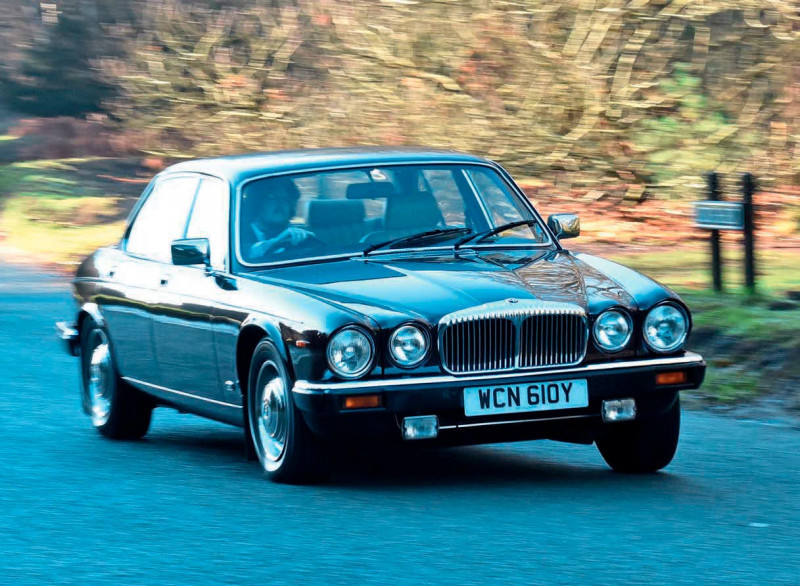
After all, the Borg-Warner Type 35 and subsequent Type 8 fitted to the six-cylinder Sovereign were perfectly adequate gearboxes. They may only have had a choice of three gears, but the ease of operation and the refinement meant that the average owner felt nothing was lacking. And courtesy of a tall final drive ratio, at cruising speed the cabin was still a quiet and comfortable place to be. Why should anyone, in these circumstances, want to change gears for themselves?
And yet here we are, with a rather beautiful Chestnut Brown 4.2 Sovereign Series 3 – in the footwell there are three pedals, and on the centre console there is a gearlever rather than an automatic transmission selector. The five-speed transmission in this car – the British Leyland LT77 – was fitted to few Jaguars, of which most were 3.4-litre XJ6 base models bought by company car users making the most use of tight budgets. At £13,950.95, the basic 3.4 XJ6 would be attainable by any company director whose fleet car choices would include the Rover SD1 Vanden Plas, the Audi 200 or the Vauxhall Royale 3000. The £338.50 needed to specify automatic transmission would have pushed its price north of £14,000, and potentially spelled the end for corporate dreams of Coventry cruising.
Not so with this manual Daimler – at £17,654.71 it was more expensive new than even the automatic Jaguar XJ6 4.2 by over £1,300, and it was no cheaper than its automatic sibling. “A five-speed manual transmission is available at no extra cost,” boasted the brochure, conveniently ignoring the cost saving such a decision would have warranted had it been ordered with the Jaguar badge.
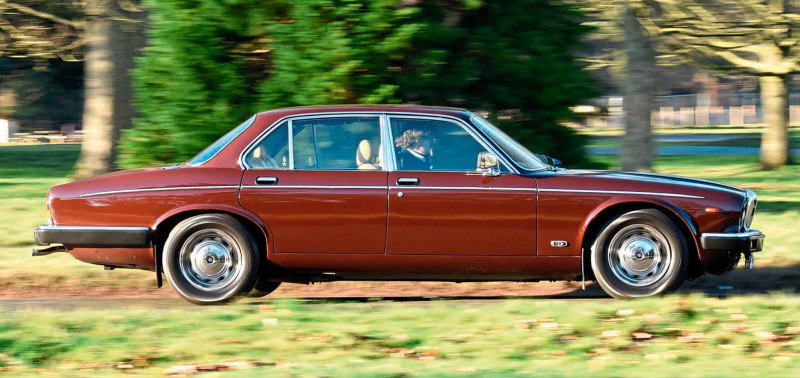
By 1983 the gearbox in question was no longer a Jaguar unit, it was a redeveloped version of the British Leyland LT77 as fitted to the Rover SD1. This unit had debuted for Jaguar in the 1979 Series 3 XJ and Daimler Sovereign, but featured changes from the Rover spec. There were bigger bearings, a stiffer tailshaft, and a shorter shift mechanism to address the complaint that the Rover unit felt somewhat agricultural in use. Jaguar engineering head Harry Mundy insisted upon a lift detente for reverse, too, rather than the knock-over system fitted to earlier manual models. The manual transmission was fitted as standard to all Jaguar XJ6 3.4 and 4.2 models, with automatic as a cost option. There would be no Daimler 3.4 for the Series 3, but the Sovereign 4.2 would be available with the manual gearbox for the same price as the automatic. The Daimler Vanden Plas was not offered as a manual.
The 1984 Jaguar and Daimler range would be very different to that of 1983 – and by November 1983 the Vanden Plas name would have been dropped from the Daimler range. This left a gap at the top of the range that was soon filled by the standard Daimler models, while Jaguar appropriated the Sovereign name for a new upmarket version of the XJ6 to sit where the Daimler Sovereign had sat in the range for the previous year. The Daimler 4.2, as the new Daimler saloon would be known, would no longer be offered with a manual gearbox – appropriately, an option introduced with the first Daimler Sovereign would depart the brand along with the name. Manual Daimlers would be listed as optional at no cost for the XJ40 and X300 ranges, but few if any were ordered.
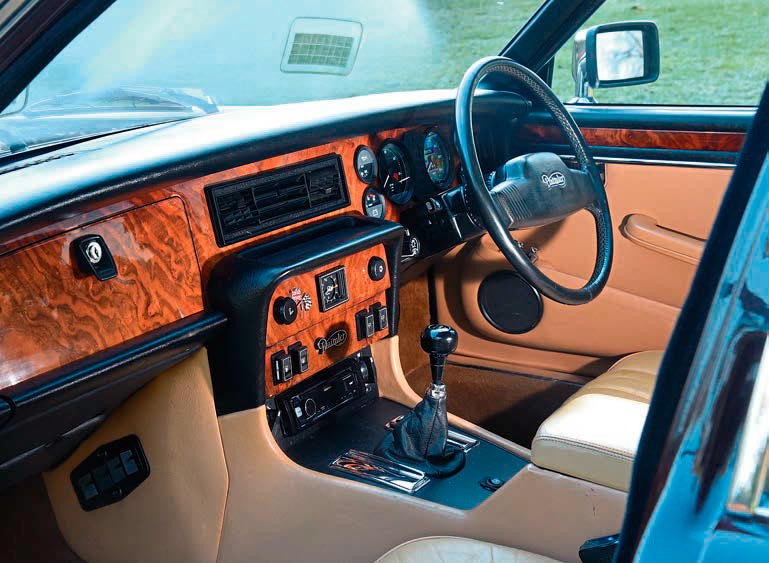
With few manual Daimlers built, the opportunity to sample one is a rare treat – and this January 1983-registered example is arguably the best Daimler Series3manual left. Fitted with its original, early Series 3 hubcaps it looks timeless despite its very period colour scheme. Inside, the cream leather is welcoming, but the gear selector looks unusual in this environment. Jaguar World ran a 1984 Jaguar Sovereign as a project car in 2018, and the rest of this car feels so familiar as a result, emphasising the alien nature of the manual transmission here. The walnut is in perfect, unfaded condition, as are the little information stickers under the air vents. There’s no sign of wear to the pedals, nor to the steering wheel. This car really does feel like a 12-month-old example. As a 1983 car this features the full Daimler script to the steering wheel in place of the earlier, stylised D – but without the walnut ski slope that the 1984 cars would bring to the centre console. As a result, it feels almost like a model trapped between two eras of Series 3 design, which adds further to the misfit feeling.
The somewhat sporting sound of the XK engine has never quite sat as well with the Daimler marque as with Jaguar, though there’s no doubt that it has the power and torque necessary for a car of its size. And there’s not really much point in us outlining the general Series 3 driving experience, which has been covered in JaguarWorld on a regular basis. Suffice to say we really fell for the Sovereign we ran one as a project car a few years ago, for its smooth ride, its ease of visibility, its light yet direct steering and its way of making the driver feel like the most important person on the planet. And all of those virtues remain present in this Daimler – it feels special, the ride is like nothing else this side of a Citroen CX, and the ease with which you can drive it belies its size. But what is important with this example is the manual gearbox, and the way it affects the car’s overall character.
It feels alien to have to slot the car into first rather than pull a lever back into D, but the pleasant surprise is that the Leyland LT77 gearbox doesn’t feel as agricultural here as it does in other installations. In an SD1, for instance, the gate feels wider and there’s definitely a longer throw, and it’s pleasing to find that this isn’t the case in this Daimler. It feels tighter, and that emphasises the pleasant shift throw. The clutch isn’t unduly heavy either and while it perhaps feels anachronistic in a Daimler to shift your own gears, it’s a good set-up for a late Seventies saloon.
The XK engine is well-matched to the box and its ratios too, the whole package feels well thought out and almost sporting. Match your revs on a downshift and point the Daimler into a corner and it’s beautiful, you can feed the power in for the exit in a manner that feels distinctly ungentlemanly. It encourages sporting driving in a manner you’d hardly expect of a sixteen-foot-long luxury saloon, and it’s grin-inducingly good fun to act accordingly. This car felt wrong at first, but the more you drive a manual Series 3 the more you realise that it’s an excellent, and underrated motor car. Age hasn’t sullied this particular example too – with mileage akin to a three-year-old example, and no real wear inside or out, it’s every bit as special as it would have been for its first owner in the mid-Eighties.
Were this a Jaguar XJ6, we’d be praising the chassis and the overall package for its poise and it would be easy to understand why the first owner of this car didn’t want to sacrifice this experience in favour of a self-shifter. But in the rarefied surroundings of the Daimler, the manual transmission and the shift in overall character feels somehow inappropriate – a solid two fingers to the brand and everything it had built itself up to be after almost five decades of effort.
What this car does is make sense of the Jaguar Sovereign of late 1983 – a way to get the finer trim associated with the Daimler and to have the manual gearbox in a car that still feels like the raffish Jaguars of the Sixties. Daimler’s reversion to type by offering only automatic models felt like the right move, and while we certainly appreciate this example, we can’t help but feel that Daimlers should have automatic transmission if only for the sake of history.
It’s hard to know quite what else might have appealed to the Daimler Sovereign manual buyer in 1983 – because most cars of this sort of calibre were automatic-only, and at this budget few luxury saloons were available in which you could change your own gears. It seems faintly idiotic to suggest that the XJ6 might have been a suitable alternative when new, because had that been the case a Daimler buyer might have saved nearly ten percent of the list price by buying a Jaguar. A BMW 735i E23 would almost certainly have had the wrong image, to say nothing of the extra £1,000 you’d have had to spend. A Monteverdi-trimmed Range Rover four-door conversion would have been similar money and offered luxury trimmings, but might have felt agricultural by comparison. The Mercedes-Benz S-Class W116/126 might have held some appeal, but the largest engine available with a manual gearbox was the entry-level, 2.8-litre 280SE W126. No other manual rival comes close on price – and manual transmission was clearly important to the person who bought this car new. It would be interesting to learn what was deemed suitable when the Daimler was finally traded in...
Today as a classic, it represents an interesting curiosity; one of the last formally available manual transmission cars from a marque which actively repelled the concept. We still think a Jaguar Sovereign or XJ6 would better suit manual transmission, but oddities like this Daimler are part of the variety of the classic car scene and it pleases us to think that when these cars were new, some buyers chose to ignore trends to create the car which met their individual needs perfectly. For what is a manual Daimler if not individual?
Thanks to: Kim Cairns Classic Cars (www.kimcairnsclassics.co.uk)
TECHNICAL DATA 1983 Daimler Sovereign 4.2 Manual
- Engine 4,235cc 6-cyl
- Max Power 205bhp
- Max Torque 236lb ft
- Max speed 131mph
- 0-60mph 8.6 secs
- Transmission 5-spd manual
- Economy 17.5mpg
- Price new £17,654.71
- Value now £15,000-£20,000
This brochure shot shows Daimler’s three-line up in the early Eighties which consisted of the Sovereign, Double Six and DS 420 limousine.


